Easter is the most sacred and important celebration of the year in Greece. Yes, even more important than Christmas. Known as ‘Pascha’, it lasts for an entire week, with preparations such as fasting occurring weeks in advance. It is considered a time to worship and serve but also a time to reflect and connect with the community and family. It is also the time when old traditions are dusted off, reminding us how the villagers must have celebrated hundreds, even thousands, of years ago.
Read below how to explore the vibrant palette of Greek Easter customs and also, discover the unique Easter customs taking place in villages all over Halkidiki!
GREEK ORTHODOX EASTER CUSTOMS
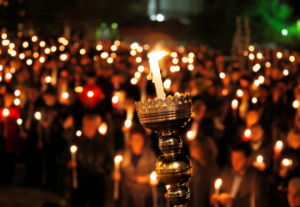
The uniqueness in celebrating Easter the traditional Greek way lies in the week leading up to the event (Holy Week) and reaches its climax on Easter Sunday. You will have the one-of-a-kind opportunity to delve into an overwhelming spiritual atmosphere and participate into sacred rituals, ancient-old traditions, gastronomical and musical celebrations (note that many non-religious Greeks follow these traditions, as they are a big part of the Greek culture).
Fasting during Lent
The seven-week period before Easter is called Lent, known in Greek as Sarakosti. During that time, some Orthodox Christians go on a special fast, which we call nistia, in order to cleanse themselves in preparation for Easter. Lent begins on Clean Monday, also known as Ash Monday
Dyeing the Red Easter eggs on Holy Thursday
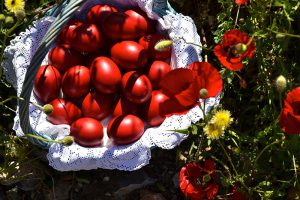 In Greece, Easter eggs are not chocolate eggs. They are real chicken eggs, but not the usual ones. They are first hard boiled and then dyed red. Traditionally, women used to dye the eggs on Holy Thursday, using a colorant produced from onion peel. This gave the eggs a deep red color, which is symbolic of the blood of Jesus Christ.
In Greece, Easter eggs are not chocolate eggs. They are real chicken eggs, but not the usual ones. They are first hard boiled and then dyed red. Traditionally, women used to dye the eggs on Holy Thursday, using a colorant produced from onion peel. This gave the eggs a deep red color, which is symbolic of the blood of Jesus Christ.
Baking Easter sweets – Tsoureki
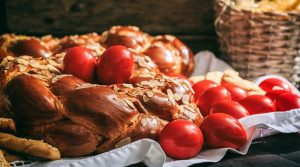 On Holy Thursday, people traditionally prepare the Easter tsoureki. It is a type of sweet bread, with a fluffy, chewy texture. It contains flour, butter, eggs, sugar, milk and spices and is often decorated with a red egg in its center.
On Holy Thursday, people traditionally prepare the Easter tsoureki. It is a type of sweet bread, with a fluffy, chewy texture. It contains flour, butter, eggs, sugar, milk and spices and is often decorated with a red egg in its center.
The Epitafios procession on Good Friday
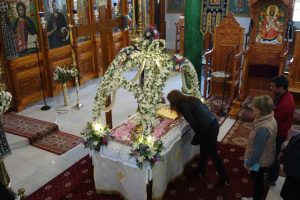 On the evening of Good Friday, every church in Greece mourns the death of Jesus, and organizes an Epitafios procession.The Epitafios is a wooden construction covered with a piece of precious cloth, often adorned in gold and silver. It depicts the dead body of Jesus and is usually decorated with flower petals.
On the evening of Good Friday, every church in Greece mourns the death of Jesus, and organizes an Epitafios procession.The Epitafios is a wooden construction covered with a piece of precious cloth, often adorned in gold and silver. It depicts the dead body of Jesus and is usually decorated with flower petals.
During this ceremony, the Epitafios is carried around the streets of each village in Halkidiki. People follow the procession around the neighbourhood, carrying candles. The procession begins and ends at the church, and it’s a uniquely solemn event.
The Anastasi (Resurrection) on Easter Saturday
On Holy Saturday, during the day, there are various church services taking place.
 Late in the evening, people gather outside the church in expectation of the Resurrection of Jesus Christ, which we call Anastasi in Greek.The Holy Light, which signifies the Resurrection, arrives from Jerusalem. Exactly at midnight, the flame quickly spreads among the crowd as everyone in the congregation lights their candle. People kiss each other on the cheek, repeating the phrases “Christos Anesti” (Jesus has risen) and “Alithos Anesti” (He has truly risen). This is a solemn event, but it is now one of joy, and is accompanied by loud chiming bells and plenty of fireworks and firecrackers.
Late in the evening, people gather outside the church in expectation of the Resurrection of Jesus Christ, which we call Anastasi in Greek.The Holy Light, which signifies the Resurrection, arrives from Jerusalem. Exactly at midnight, the flame quickly spreads among the crowd as everyone in the congregation lights their candle. People kiss each other on the cheek, repeating the phrases “Christos Anesti” (Jesus has risen) and “Alithos Anesti” (He has truly risen). This is a solemn event, but it is now one of joy, and is accompanied by loud chiming bells and plenty of fireworks and firecrackers.
Then everyone returns home, holding their lit candles. It is customary to make a cross out of candle smoke on the ceiling, just above the entrance door. This symbolizes the fact that Christ is risen from the dead.
Cracking the red eggs
As everyone returns home after the Anastasi, it is time for some fun! The family sits around the table, and everyone gets ready to crack the red eggs into each other.
One person holds their egg in their hand, and the other person tries to break the egg saying the phrase “Christos Anesti”. The response is “Alithos Anesti”. Sometimes both eggs might break!
Everyone gets to crack a number of eggs with other people. The person who is left with the only uncracked egg is the winner and will have good luck for the next year to come. In the end, everyone gets to eat their eggs.
Cracking the eggs is symbolic of the Resurrection of Jesus, and the eternal life.
Eating the mayiritsa Easter soup
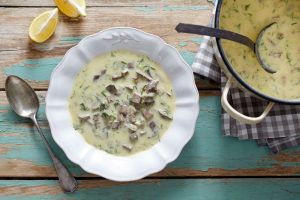 After eating the eggs, Greeks have the traditional midnight meal, which we call magiritsa or mayiritsa. It is a special soup containing goat or lamb intestines, kidneys and other inside parts. It also contains rice, herbs and lots of lemon, to balance the strong flavor and take some of the meatiness away.
After eating the eggs, Greeks have the traditional midnight meal, which we call magiritsa or mayiritsa. It is a special soup containing goat or lamb intestines, kidneys and other inside parts. It also contains rice, herbs and lots of lemon, to balance the strong flavor and take some of the meatiness away.
Feasting on goat or lamb on Easter Sunday
Meat lovers, rejoice! After the long period of Lent, it is time for Greeks to go back to one of the country’s favourite foods: meat.
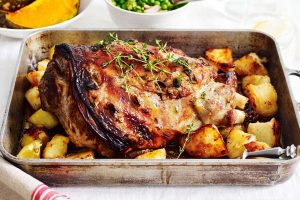 The procedure begins early in the morning and continues until late in the evening. Apart from roasted lamb or goat, you can usually find kokoretsi and gardoumpes, meat delicacies made with the various lamb and goat entrails.
The procedure begins early in the morning and continues until late in the evening. Apart from roasted lamb or goat, you can usually find kokoretsi and gardoumpes, meat delicacies made with the various lamb and goat entrails.
A proper Easter table also has potatoes, salads, various pies and the red Easter eggs. Not to mention wine, beer, and more Greek drinks. This is a good chance to listen to some traditional Greek folk music and try some dancing!
LOCAL EASTER CUSTOMS
The Burning of Judas and the Kantari
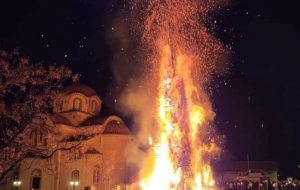 One of the most distinguished customs of Easter in Halkidiki is the burning of Judah on Holy Saturday. When the holy light is spread and people sing that Jesus Christ has Risen hymn, Judah is burned and so is evil. Other places where you can see the Burning of Judah are: Pefkohori, Hanioti, Gomati, Galarino, Megali Panagia and Neos Marmaras.
One of the most distinguished customs of Easter in Halkidiki is the burning of Judah on Holy Saturday. When the holy light is spread and people sing that Jesus Christ has Risen hymn, Judah is burned and so is evil. Other places where you can see the Burning of Judah are: Pefkohori, Hanioti, Gomati, Galarino, Megali Panagia and Neos Marmaras.
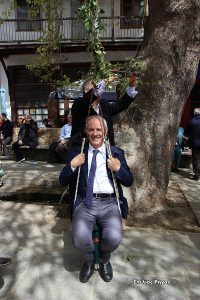 Easter Sunday is celebrated with lamb, egg fights, and tsoureki while in the mountainous area of Arnea, the locals wear traditional costumes, treat visitors with red eggs, and get ready for the tradition of Kantari. This takes place the following day and involves a scale where people are weighed. In the square of Arnea, there is a hanging "kantari", scale where all villagers go to be weighed. The one that weighs the more –which means that has eaten the most the previous day– is the winner.
Easter Sunday is celebrated with lamb, egg fights, and tsoureki while in the mountainous area of Arnea, the locals wear traditional costumes, treat visitors with red eggs, and get ready for the tradition of Kantari. This takes place the following day and involves a scale where people are weighed. In the square of Arnea, there is a hanging "kantari", scale where all villagers go to be weighed. The one that weighs the more –which means that has eaten the most the previous day– is the winner.
Black Aloni & Of Khar’kou t’Aloni
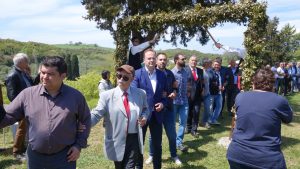
The rituals known as Black Aloni in Ierissos and of khar’kou t’aloni in Palaiochori go back to the days of the Turkish rule. Three days after Easter, the locals in Ierisso hold a memorial and the reconstruction of hundreds of people slaughtered during the Greek War of Independence in 1821. It is a chance for visitors to experience some customs that provide a hint of history too.
In Paleochori revives the custom of "Of Khar' kou t' aloni". In the old temple of Archangel Michael there is a ceremony and then a great feast. Dance and custom is called "T khalkou T' aloni" and refers to the slaughter of the inhabitants of Paleochori.
Horse Racing & Egg Fights
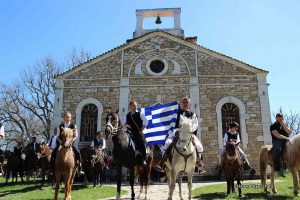 Tuesday is a day full of feasts for Lakoma and Mesimeri villages where the people start… egg fights! This is a tradition that symbolizes the clash between good and evil and Christ’s resurrection. The same day, the people in Sykia organize a horse race and the ceremony involves the riders carrying the icon of the local church’s saint. In Ierissos, the residents set off on a line dance led by the elders that can reach hundreds of meters in length and ends with the Kageleftos, a reenactment of the slaughter of 400 Ierissos inhabitants by the Ottomans in 1821.
Tuesday is a day full of feasts for Lakoma and Mesimeri villages where the people start… egg fights! This is a tradition that symbolizes the clash between good and evil and Christ’s resurrection. The same day, the people in Sykia organize a horse race and the ceremony involves the riders carrying the icon of the local church’s saint. In Ierissos, the residents set off on a line dance led by the elders that can reach hundreds of meters in length and ends with the Kageleftos, a reenactment of the slaughter of 400 Ierissos inhabitants by the Ottomans in 1821.
Koutsamos and Sousaritsa
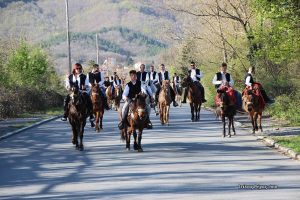 On the third day, in Arnea, "Koutsamos and Sousaritsa" customs revive. At 8 o'clock men with traditional uniforms and armed are gathered with horses in Arnea Square. While they singing, they go to the Prophet Elias church, outside the village and after the ceremony, shooting with red eggs as targets begins as well as horse racing, followed by a feast full of music, dancing. Later on the villagers are being divided according to their age and compete at “Sousaritsa”: they throw red eggs as far as they can, trying not to break them.
On the third day, in Arnea, "Koutsamos and Sousaritsa" customs revive. At 8 o'clock men with traditional uniforms and armed are gathered with horses in Arnea Square. While they singing, they go to the Prophet Elias church, outside the village and after the ceremony, shooting with red eggs as targets begins as well as horse racing, followed by a feast full of music, dancing. Later on the villagers are being divided according to their age and compete at “Sousaritsa”: they throw red eggs as far as they can, trying not to break them.









